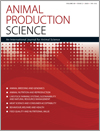
Animal Production Science
Volume 60 Number 2 2020
AN19161Animal science Down Under: a history of research, development and extension in support of Australia’s livestock industries
This historical review tells the story of people and institutions that have contributed scientifically to the productivity and economic success of the Australian livestock industries. The development of major scientific disciplines and their application to research outcomes and industry impacts are emphasised. Finally, some present and likely future challenges facing the Australian industries are discussed, together with opportunities for possible scientific solutions.
AN19161 Abstract | AN19161 Full Text | AN19161PDF (837 KB) Open Access Article
AN18632Dietary nitrate metabolism and enteric methane mitigation in sheep consuming a protein-deficient diet
Dietary nitrate can replace urea as a non-protein nitrogen source for ruminants. The current experiment in sheep consuming a protein-deficient chaff confirmed nitrate reduced methane emissions but also found that plasma nitrate is concentrated into saliva. In contrast, the inclusion of cysteamine hydrochloride in a low-quality diet was ineffective in improving animal performance or reducing ruminant enteric methane emissions.
AN18700Effects of phytogenic inclusion level on broiler carcass yield, meat antioxidant capacity, availability of dietary energy, and expression of intestinal genes relevant for nutrient absorptive and cell growth–protein synthesis metabolic functions
Phytogenic applications in animal diets are viewed positively by farmers and consumers because of their plant-based origin and potential for sustainable, high-quality broiler meat production; however, this potential remains to be explored. Phytogenic composition and dietary inclusion levels are critical factors for overall phytogenic efficacy that should be researched on a case-by-case basis. This study has highlighted implications of phytogenics in improving meat yield and antioxidant capacity, including chicken digestive and metabolic processes relevant for production.
AN18270Dietary supplementation with copper oxide nanoparticles ameliorates chronic heat stress in broiler chickens
 , Karima El-Naggar, Safaa E. Abdo, Walied Abdo, Abeer A. K. Kirrella, Ibrahim El-Mehaseeb and Mohammed Abu El-Magd
, Karima El-Naggar, Safaa E. Abdo, Walied Abdo, Abeer A. K. Kirrella, Ibrahim El-Mehaseeb and Mohammed Abu El-Magd
Copper improves birds’ antioxidant activities and is usually added at a higher concentration to increase its bioavailability, leading to environmental pollution. Using nano copper improves its bioavilability and decreases environmental pollution. Heat stress is one of the challaenging problems in poultry production that negatively affects bird performance and welfare. Dietary supplementation of CuO-NPs, especially at 50% of the birds’ recommended requirement, during heat stress could enhance bird performance, lower bird temperature and increase its resistance to negative consequences of elevated temperature.
AN18719Comparison of selenium bioavailability in milk and serum in dairy cows fed different sources of organic selenium
In this study we compared the effectiveness of (S2)-2-amino-4-methylselenylbutanoic acid (SM1), R,S-2-hydroxy-4-methylselenobutanoic acid (SM2), and a selenium-yeast (SY) supplemented at three doses: 0.1, 0.2 and 0.3 ppm organic selenium in addition to 0.3 ppm of inorganic selenium to transfer selenium in milk and serum of dairy cows, and showed that SY is more effective than SM1 and SM2 at increasing selenium transfer into milk.
AN17595Influence of a mineral supplement containing calcium, phosphorus and micronutrients on intake, digestibility, performance and mineral status of young Nellore bulls in a feedlot
A reduction in mineral supplementation reduces environmental pollution and the cost of beef production. The results obtained in the present study showed that young bulls fed low-mineral feedlot diets for 125 days had the same performance as those fed diets that meet mineral requirements. Thus, the usual nutritional systems are overestimating mineral requirements.
AN18416Desirable effects of dietary 4-O-methyl-glucuronoarabinoxylan from the Echinacea plant on growth performance, thigh meat quality and development of small intestine in female Partridge-Shank broilers
Purified 4-O-methyl-glucuronoarabinoxylan (4OMG) is a polysaccharide found in Echinacea purpurea that plays an important role in improvement of growth performance and meat quality. Dietary supplementation with 4OMG may improve growth rate and thigh meat quality and better development of small intestine of female Partridge-Shank broilers. Knowing the positive effects of dietary 4OMG growth and meat quality may open the possibility of manipulating more-economic diets adjusted for improving broilers production.
Probiotics have potential to improve health of laying hens, thus improving the overall quality of eggs. In this study, probiotics did not enhance production, egg quality or serum profile; however, a higher ratio of H2S : COS, (CH3)2S : COS, CH3SH : COS and CS2 : COS were observed in the group fed probiotics. Probiotics were likely provided in excess, limiting bacterial colonisation and beneficial effects.
Behavioural responses of cattle during periods of high heat load can provide information about animal comfort and the timing of alleviation strategies. Results from the present study further highlight the benefits of providing shade to feedlot cattle, particularly Bos taurus genotypes. However, Bos indicus within the present study exhibited purposeful behavioural responses, via increased shade usage and respiratory dynamics. These results suggest that Bos indicus cattle do respond (behaviourally and physiologically) when exposed to high heat load.
AN18600Development of batch processing to obtain bioactive materials from pork byproducts
Batch-processing methods were developed to obtain bioactive materials from pork byproducts. Bioactive materials (i.e. collagen, peptide, heparin, conjugated linoleic acid and ursodeoxycholic acid) were obtained from pork byproducts using batch processing. Batch processing methods can convert pork byproducts into value-added materials.
AN18075Effect of growth path on carcass and meat-quality traits of Hereford steers finished on pasture or in feedlot
Producers have not given importance to nutritional status after weaning and before the fattening period. To address this issue, research is needed to understand the effects of different nutritional-management pathways during rearing on subsequent finishing on pasture or in feedlot. Pasture production proved to be the best pathway to provide high quality and healthier products in Uruguay.



